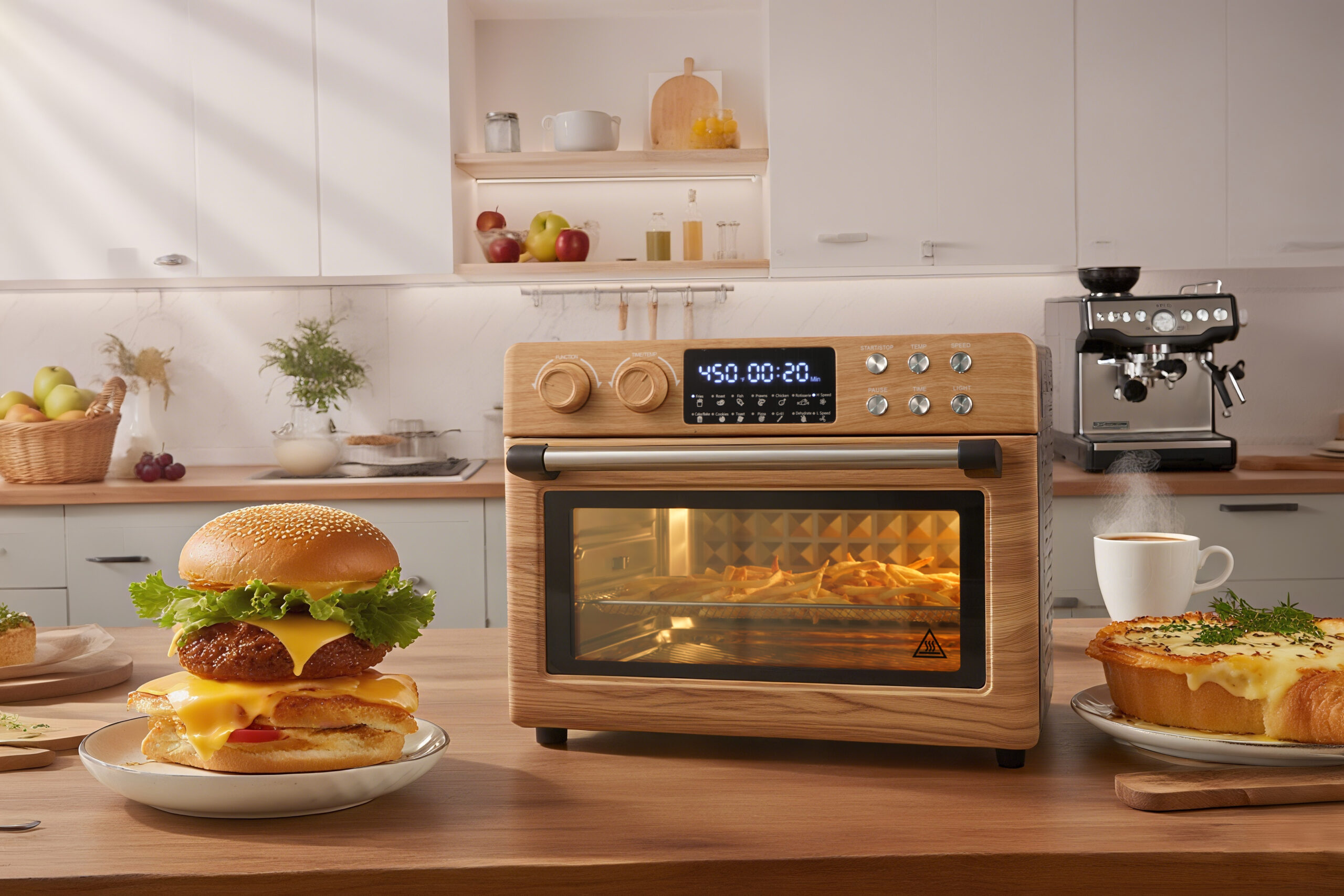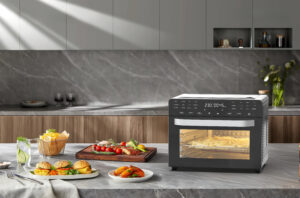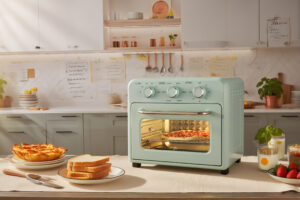As the Sales Manager at Foshan Linden Intelligent Appliances Co., Ltd., I’m passionate about helping home cooks find appliances that make cooking faster and more convenient. From our factory in China, we produce high-quality 12L, 16L, and 30L air fryer ovens, air fryers, and food dehydrators, exported to North America, Europe, Russia, and the Middle East. A question I often hear at trade shows and through our website, lindensmart.com, is: How do air fryer ovens compare to conventional ovens in cooking speed and convenience? I’m excited to share my expertise and compare these appliances to help you choose the best for your kitchen.
In this article, I’ll explore air fryer ovens and conventional ovens, focusing on their cooking speed, convenience, and practicality for everyday use. Drawing from our experience at Linden, where we design innovative appliances with customizable settings, I’ll break down the pros and cons to guide your decision. Let’s dive into which appliance offers better speed and convenience for your cooking needs!
What Are Air Fryer Ovens and Conventional Ovens?
Both air fryer ovens and conventional ovens are essential for home cooking, but their designs and functions differ. Understanding these appliances is key to evaluating their speed and convenience.
Air Fryer Ovens: Versatile and Compact
Air fryer ovens are multi-functional countertop appliances. They use rapid air circulation to cook food, delivering crispy textures with minimal oil. Our air fryer ovens combine frying, baking, roasting, grilling, and dehydrating, making them ideal for quick meals.
Conventional Ovens: Traditional and Spacious
Conventional ovens are larger appliances, often built-in or freestanding. They use radiant heat from electric or gas elements to cook food. They’re designed for baking, roasting, and broiling, especially for large dishes.
Why Compare Speed and Convenience?
I’ve seen busy cooks prioritize appliances that save time and effort. Comparing air fryer ovens and conventional ovens helps you select the one that fits your lifestyle, kitchen space, and cooking habits.
How Air Fryer Ovens Work
Our air fryer ovens use high-speed air circulation to distribute heat. A powerful fan and heating element create a hot air vortex, cooking food evenly and quickly. According to Consumer Reports, air fryer ovens cook up to 30% faster than conventional ovens. Our 16L model, for example, can roast vegetables in 10–15 minutes.
Key Features of Air Fryer Ovens
Rapid Air Technology: Ensures even cooking.
Compact Design: Fits small kitchens.
Multi-Functional: Fries, bakes, roasts, grills, and dehydrates.
Precise Controls: Customizable temperature and time settings.
How Conventional Ovens Work
Conventional ovens use radiant heat from top and bottom elements to cook food. They maintain steady temperatures in a larger chamber, ideal for baking or roasting. They’re reliable but slower to preheat, per CNET.
Key Features of Conventional Ovens
Large Capacity: Suits family-sized meals.
Steady Heat: Consistent for baking and roasting.
Versatile Modes: Supports multiple cooking functions.
Traditional Operation: Familiar to most cooks.
Comparing Cooking Speed
Cooking speed is a major factor for convenience. Let’s compare how air fryer ovens and conventional ovens perform in terms of time.
Air Fryer Ovens: Faster Cooking Times
Our air fryer ovens cook meals in minutes. For example, our 12L model prepares crispy fries in 12–15 minutes at 400°F, with no preheating needed. The rapid air circulation heats food quickly, reducing overall cooking time by 30%, per Consumer Reports.
Speed for Small Meals
Air fryer ovens excel for small portions, like chicken breasts or veggies, ready in 10–20 minutes. This makes them ideal for quick weeknight dinners.
Speed for Batch Cooking
Our 30L model handles larger batches, like a whole chicken in 25–35 minutes, faster than conventional ovens for similar results.
Conventional Ovens: Slower but Steady
Conventional ovens require preheating (5–10 minutes) and longer cooking times (20–60 minutes). For example, baking a tray of cookies takes 10–12 minutes plus preheat, increasing total time.
Speed for Small Meals
Conventional ovens are less efficient for small meals, as the large chamber takes longer to heat. This wastes time and energy.
Speed for Batch Cooking
Conventional ovens are better for large batches, like multiple trays, but overall times are longer due to preheating and slower heat transfer.
Comparing Convenience
Convenience goes beyond speed. Let’s compare ease of use, cleanup, and versatility.
Ease of Use
Air Fryer Ovens: Intuitive Controls
Our air fryer ovens feature digital displays and preset modes, making them easy to use. You can set the temperature (e.g., 375°F for roasting) and walk away, perfect for beginners.
Conventional Ovens: More Manual
Conventional ovens require manual temperature adjustments and monitoring. They’re familiar but less convenient for quick tasks.
Cleanup and Maintenance
Air Fryer Ovens: Quick Cleanup
Our air fryer ovens have non-stick, dishwasher-safe trays, making cleanup effortless. The compact interior wipes down in minutes, per Good Housekeeping.
Conventional Ovens: More Effort
Conventional ovens have larger interiors and racks, requiring scrubbing for spills. This can be time-consuming, especially after greasy meals.
Versatility
Air Fryer Ovens: Multi-Purpose Cooking
Our air fryer ovens handle frying, baking, roasting, grilling, and dehydrating. This versatility makes them ideal for diverse recipes, from crispy fries to baked cookies.
Conventional Ovens: Baking-Focused
Conventional ovens excel at baking and roasting but lack the quick frying or grilling options of air fryer ovens. They’re less versatile for fast, varied cooking.
Comparing Health Benefits
Health benefits enhance convenience for wellness-focused cooks. Let’s see how these appliances compare.
Air Fryer Ovens: Low-Fat Cooking
Our air fryer ovens use minimal oil, reducing fat by 70–80%, per Harvard Health. This makes them ideal for healthy meals like roasted vegetables or chicken.
Nutrient Retention
The fast cooking times (10–30 minutes) preserve nutrients like vitamin C, per WebMD. Our 16L model roasts broccoli without losing freshness.
Conventional Ovens: Moderate Health Benefits
Conventional ovens can produce healthy dishes but often require more oil to prevent drying. Longer cooking times may degrade nutrients, per Healthline.
Nutrient Retention
Conventional ovens preserve minerals but can reduce vitamins in prolonged cooking, like baking for 40 minutes.
Comparing Energy Efficiency
Energy efficiency ties into convenience and cost. Let’s compare power use.
Air Fryer Ovens: Eco-Friendly
Our air fryer ovens use 1–1.5 kWh per use, per Energy Star. Their fast cooking times make them efficient for daily use.
Conventional Ovens: Higher Energy Use
Conventional ovens use 2–5 kWh, especially with preheating. They’re less efficient for small meals, impacting energy bills.
Comparing Space Requirements
Space is a factor for convenience. Let’s see how these appliances fit.
Air Fryer Ovens: Compact Design
Our air fryer ovens, like the 12L and 16L models, are countertop-friendly, ideal for small kitchens. They save space while offering versatility.
Conventional Ovens: Larger Footprint
Conventional ovens require more space, often built-in. They’re less practical for compact kitchens or apartments.
Practical Applications for Home Cooking
Both appliances suit different cooking scenarios. Here’s how they perform.
Air Fryer Ovens: Quick, Healthy Meals
Our 16L air fryer oven is perfect for fast meals, like roasted chicken or veggies, ready in 10–20 minutes. It’s ideal for busy weeknights.
Conventional Ovens: Large-Scale Cooking
Conventional ovens excel for family-sized dishes like casseroles or roasts, but they take longer and use more energy.
Quality and Reliability
At Linden, quality is our foundation. Our air fryer ovens undergo rigorous testing, meeting UL and CE standards for durability and safety. Home cooks trust us for reliable performance.
Logistics and Customer Support
From my experience with global buyers, logistics matter. Our air fryer ovens are lightweight and easy to ship, ensuring timely delivery. We optimize production for tight schedules. Need help? I’m here at sales1@fslinden.com for expert advice.
SEO-Friendly Tips for Choosing an Appliance
To pick the best appliance for cooking speed and convenience, here are tips optimized for search terms like “air fryer oven vs conventional oven” or “fast cooking appliances”:
- Prioritize Speed: Choose air fryer ovens for quick meals.
- Focus on Convenience: Opt for user-friendly controls.
- Check Versatility: Look for multi-functional options.
- Read Reviews: Explore platforms like CNET for insights.
- Test at Trade Shows: Try appliances hands-on to evaluate performance.
Final Thoughts: The Best Choice for Speed and Convenience
As someone who loves helping home cooks, I believe our air fryer ovens are the better choice for most households. Their cooking speed, convenience, and versatility make them ideal for busy lifestyles. Conventional ovens are great for large-scale cooking but fall short in efficiency and ease for daily use. Your choice depends on your cooking habits, kitchen size, and priorities.
Ready to upgrade your cooking? Visit lindensmart.com to explore our air fryer ovens, or email me at sales1@fslinden.com for personalized guidance. Let’s make your cooking faster and more convenient!
Meta Title: Air Fryer Oven vs Conventional Oven: Speed and Convenience Compared Meta Description: Compare air fryer ovens and conventional ovens for cooking speed and convenience. Discover which is better for your kitchen.





